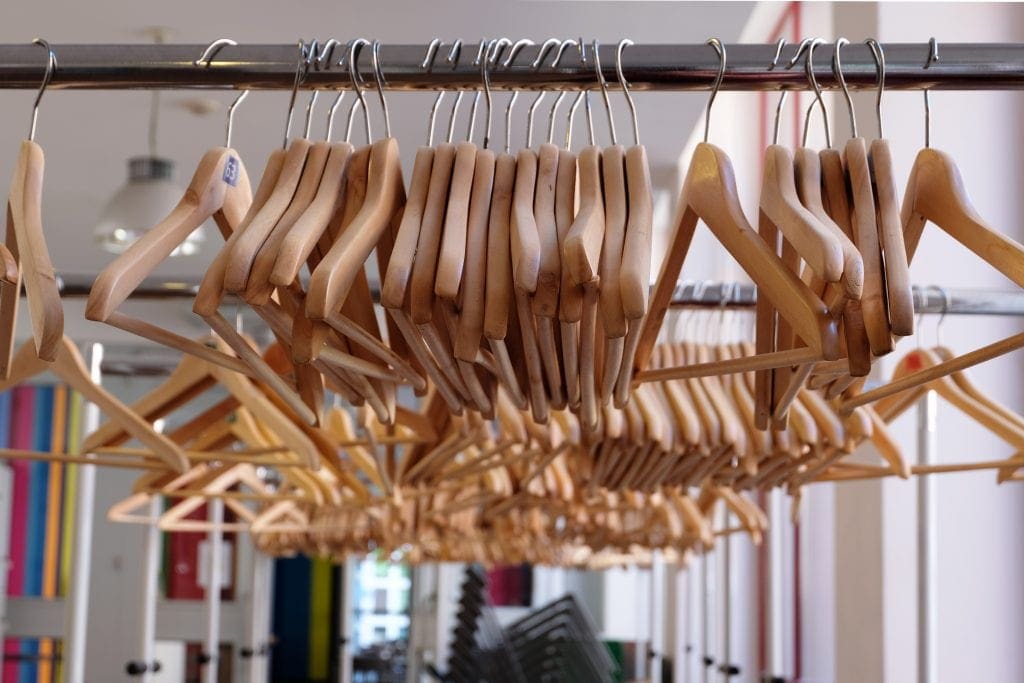
As we get to grips with the unglamorous side of our consumer habits, the fashion business is among those being forced to respond. Buzzwords like “sustainability” have rocked the industry, uprooted its foundations and jolted it into rethinking its appetite for excess. Implemented correctly, eco-friendly practices look good on the balance sheet, boosting operating incomes by up to 2%, Boston Consulting Group figures suggest. Done badly, firms rightly face accusations of “greenwashing.” With fashion’s impact on the environment no longer a backstage issue, leading brands are switching fabrics to kinder alternatives, using alternatives to leather, or organic cotton. But if they’re taking their environmental footprint seriously, they’re thinking about how their clothes are packaged, too.
“We’re All Guilty”
As photographers circled a small group of Extinction Rebellion protesters staging a ”die-in” outside the first day of London Fashion Week SS20, one corner room inside a building on central London’s The Strand was abuzz with PRs, reporters and industry insiders surrounding Roland Mouret, the fashion designer, who teamed up with Sjoerd Fauser and Anne Mas, cofounders of sustainable hanger startup Arch and Hook. The Amsterdam-based brand was officially launching BLUE, a hanger created to help combat the billions of pieces of plastic used by retailers that are dumped into the ocean every year.
Figures vary, but the company calculates that 150 billion garments are produced around the world each year, and that of those, two thirds are transported from factory to store using plastic hangers most likely made using polystyrene, widely not recycled, in what is called the “garment on hanger” process. These aren’t the hangers you see on the shop floor, because they are discarded in favour of branded in-store hangers. Although wasteful, the process saves retailers time as it leaves fewer wrinkles on the garment, meaning it is ready to be displayed faster.
At the heart of the brand’s mission with the BLUE hanger, nicknamed the “soldier” by CEO Fauser, is to replace this unseen piece of polystyrene used to transport garments from the factory to the shop floor. “Let’s be honest, fashion is terrible for the environment,” Mas told Forbes. “It’s not durable. When something is not hot anymore you throw it out, and we’re all guilty.”
Mouret, whose generation of designers sped up the fashion season cycle from “two collections to six collections” a year, he says, was inspired to sign up to Arch and Hook’s mission after being introduced to Fauser by the British Fashion Council. “What we have created is a monster,” he told Forbes. Mouret labels the hangers the “the penicillin of fashion,” attempting to fight off the industry’s plastic-related ills.
Amid a chorus of statistics warning of fashion’s devastating impact on the environment, the company knows how to frame the issue to capture imaginations anew, comparing the scale of the hanger problem to the size of the Empire State Building and the Big Ben in their advertising campaign. The company estimates that out of those billion of hangers, which are only used once, 85% will end up in landfill, “taking more than 1,000 years to degrade.”
The messaging is getting through—the four-year-old company recently came through its Series B funding round, meaning Arch & Hook has now raised “tens of millions” of euros, according to Fauser. Sixteen retailers and designers—who are yet to be revealed—have signed up to use BLUE hangers since mid-September. Retailers are expected to return the hangers to the company to be reused or remade.
Hunting For Rubbish
Arch & Hook, which touts itself as the world’s “number one” sustainable hanger brand, sold its first Forest Stewardship Council-certified wood hanger designed for in-store use, in 2017. After gaining interest from luxury brands including YSL and Vetements, but struggling to meet the fast demand from their clients, the cofounders began to consider new materials they could use, including plastic. “We thought, if we’re going to go into plastics, we can not only on one side of the business sell fully sustainable wooden hangers and then on the other side of the business, partake in what we’re trying to cut,” Fauser said.
In June, the company, which hired around 50 people worldwide, launched their “Mission-E” hanger made from recycled materials, before launching BLUE in September following two years of research for it. The hangers are produced from riverine debris from four of China’s largest rivers, including the Yangtze and the Yellow, which is collected before it reaches the sea. The materials are sorted and separated before being shredded and injection-moulded into the modular hangers that can be used for garments including T-shirts and trousers. China, which banned imports of foreign nations’ plastic waste in 2018, has approved Arch and Hook’s unique supply chain while providing the company with the relevant contacts for their recycling and garbage collection efforts, Fauser said.
Stemming The Flow
Disposable hangers are just one part of the equation. A cursory scroll through YouTube (no longer just a video-sharing platform, but also a hub of consumerism) will likely present you with an “unboxing” video of some sort, in which the vlogger will often fixate on the weight and quality of the packaging, giving it almost equal attention to the product within it. PR unboxings generate thousands of views for influencers, pushing brands to create increasingly theatrical packaging.
To attempt to offset this, Delta Global CEO Robert Lockyer, who has worked in luxury packaging for 28 years, consults brands on ways that packaging can be designed for reuse as a storage item, or for recycling. “I think it’s a final realisation that every business has a responsibility to do something about the voracious consumerism and waste we’ve had over the last 30 or 40 years,” he told Forbes. Lockyer counts luxury retailers Matches Fashion, Net-A-Porter, Tom Ford, La Mer and Ted Baker among his clients, adding that it’s the luxury brands that allow for more innovation when it comes to packaging compared with cost-conscious fast fashion brands. Matches Fashion told Forbes that 65% of their customers “try to live as sustainably as possible,” so making their packaging easily recyclable and free from plastic was a “priority.” Their signature marbled boxes contain a water-based finish and can be reused.
Across the EU, the amount of packaging waste produced each year outpaces efforts to recover and recycle it. And while plastic bags and straws bear much of the backlash where single-use plastics are concerned, throwaway hangers are a more harmful culprit, Fauser says, because they are often made from a mixture of different plastics and therefore harder to recycle. Polystyrene is not widely recycled in the U.K., U.S. and Europe.
Yet, as Arch and Hook tries to stem the flow, the level of waste gushes towards them at a much faster rate than they can clean up. “There’s a lot of plastic in the ocean, so if we can sell over 1 billion hangers in an extended amount of time, we would be cleaning anywhere [up to 2%] of what’s out there,” Fauser said.
“There is so much out there, and that’s calculating that there won’t be anymore plastic put into the ocean.”
Arch & Hook’s contribution might be a drop in the ocean yet, if the innovation is adopted widely by the world’s most influential retailers, it could be one sign that the fashion industry is handling its sustainability problem seriously—not merely as a vanity project.
Source: Forbes








